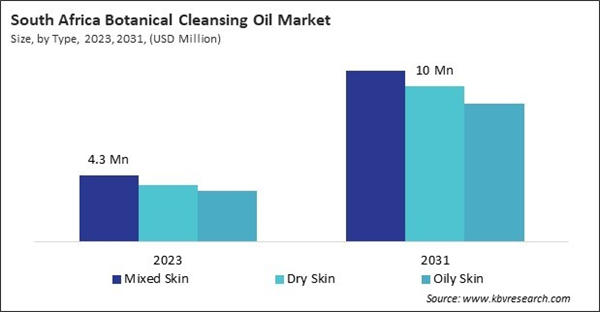The market for dry skin types caters to individuals seeking gentle yet effective skincare solutions that hydrate and nourish their skin. These oils formulated specifically for dry skin typically contain a blend of natural oils such as jojoba, avocado, and argan oil, known for their moisturizing properties. Thus, the Brazil market consumed 40.16 tonnes of Botanical Cleansing Oil in dry skin type segment in the year 2023.
The Brazil market dominated the LAMEA Botanical Cleansing Oil Market by Country in 2023 and would continue to be a dominant market till 2031; thereby, achieving a market value of $67 Million by 2031. The Argentina market is showcasing a CAGR of 14% during (2024 - 2031). Additionally, The UAE market would register a CAGR of 12.7% during (2024 - 2031).
Botanical cleansing oils offer a versatile and convenient skincare solution, serving multiple purposes in a single product. From makeup removal to deep cleansing, hydration, and anti-aging benefits, these oils streamline the skincare routine, eliminating the need for multiple products and simplifying the overall regimen. Also, positive word-of-mouth recommendations from satisfied users contribute to the growing adoption of these oils.
The market is characterized by dynamic trends that reflect evolving consumer preferences, technological advancements, and industry innovations. These trends shape the market’s landscape, influencing product development, marketing strategies, and consumer behaviour. A growing emphasis on sustainability and environmental consciousness drives demand for botanical cleansing oils packaged in recyclable or biodegradable materials.
Rising retail sales in Brazil contribute to the overall growth and expansion of the market. As consumer spending increases, there is a corresponding rise in demand for skincare products, including such oils, driving sales volumes and market growth. In conclusion, the increasing e-commerce sector and rising retail sales in the region drive the market’s growth.
Based on Distribution Channel, the market is segmented into Online and Offline. Based on Type, the market is segmented into Mixed Skin, Dry Skin, and Oily Skin. Based on countries, the market is segmented into Brazil, Argentina, UAE, Saudi Arabia, South Africa, Nigeria, and Rest of LAMEA.
List of Key Companies Profiled
- Kao Corporation
- Unilever PLC
- L'Oreal S.A.
- Avon Products, Inc. (Natura &Co Holding S.A.)
- Johnson & Johnson
- Activist Skincare LLC
- The Procter and Gamble Company
- The Clorox Company
- The Colgate Palmolive Company
- COSRX, Inc. (Amorepacific Corporation)
Market Report Segmentation
By Distribution Channel (Volume, Tonnes, USD Billion, 2020-2031)- Online
- Offline
- Mixed Skin
- Dry Skin
- Oily Skin
- Brazil
- Argentina
- UAE
- Saudi Arabia
- South Africa
- Nigeria
- Rest of LAMEA
Table of Contents
Companies Mentioned
- Kao Corporation
- Unilever PLC
- L'Oreal S.A.
- Avon Products, Inc. (Natura &Co Holding S.A.)
- Johnson & Johnson
- Activist Skincare LLC
- The Procter and Gamble Company
- The Clorox Company
- The Colgate Palmolive Company
- COSRX, Inc. (Amorepacific Corporation)
Methodology

LOADING...









